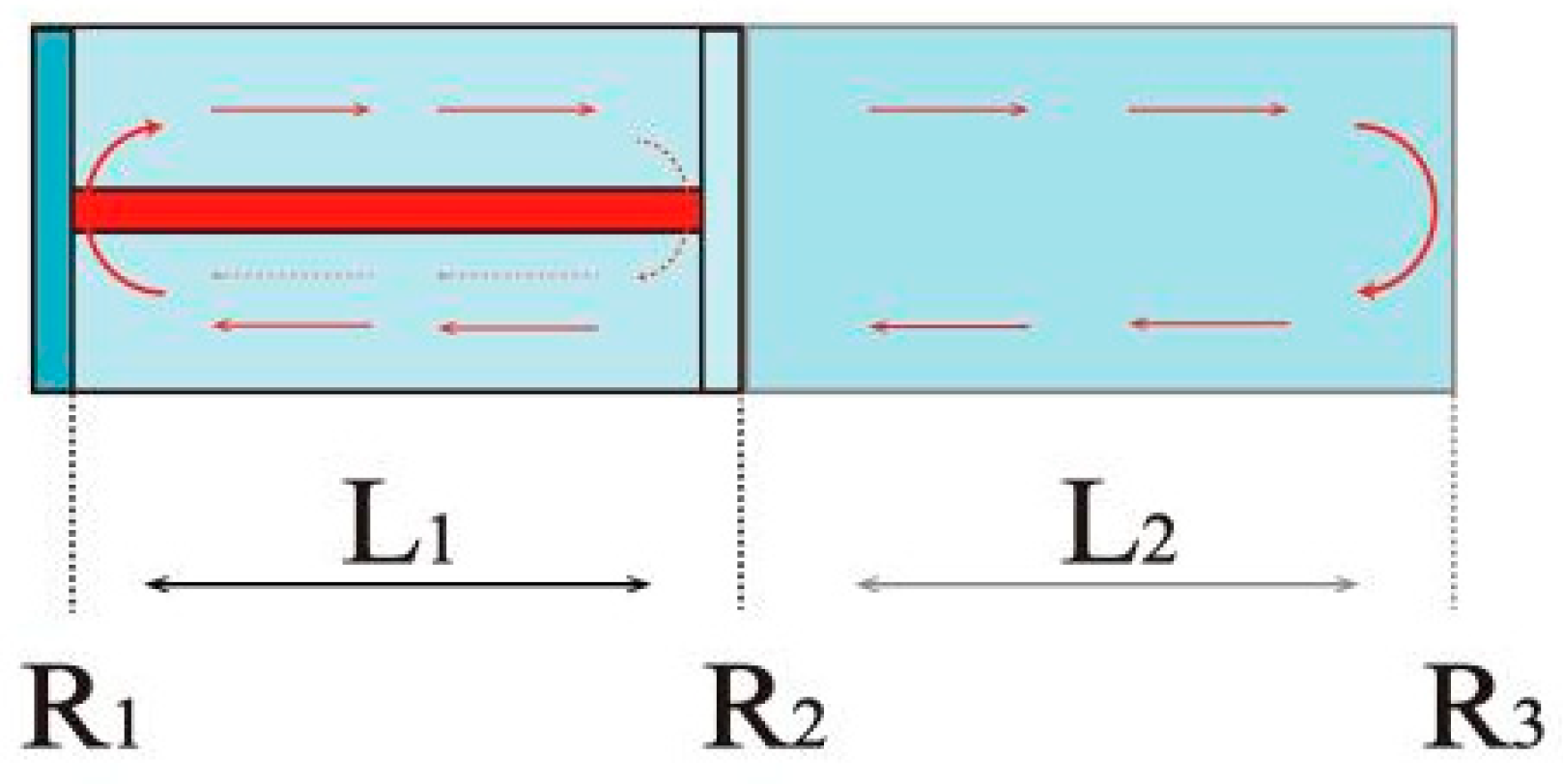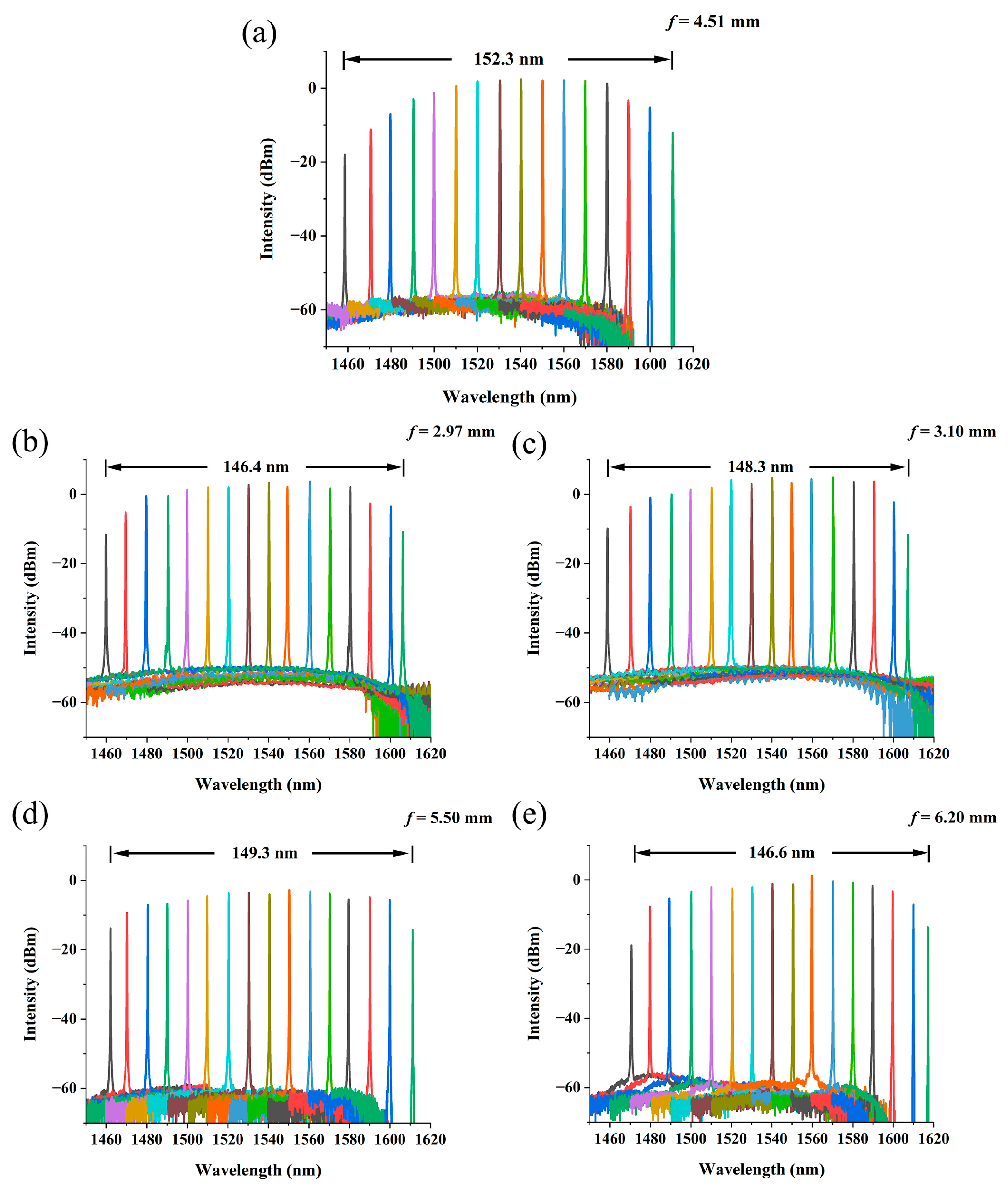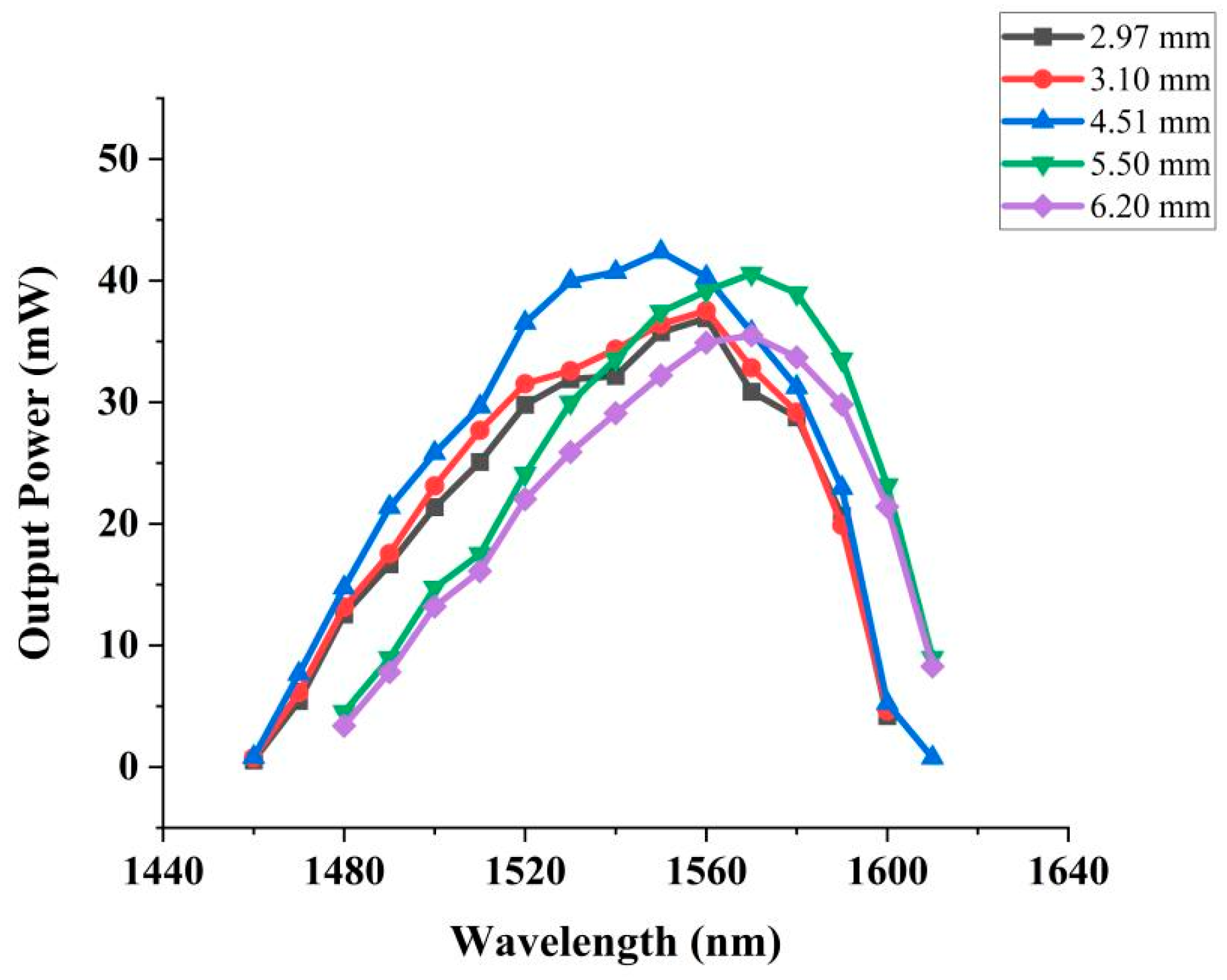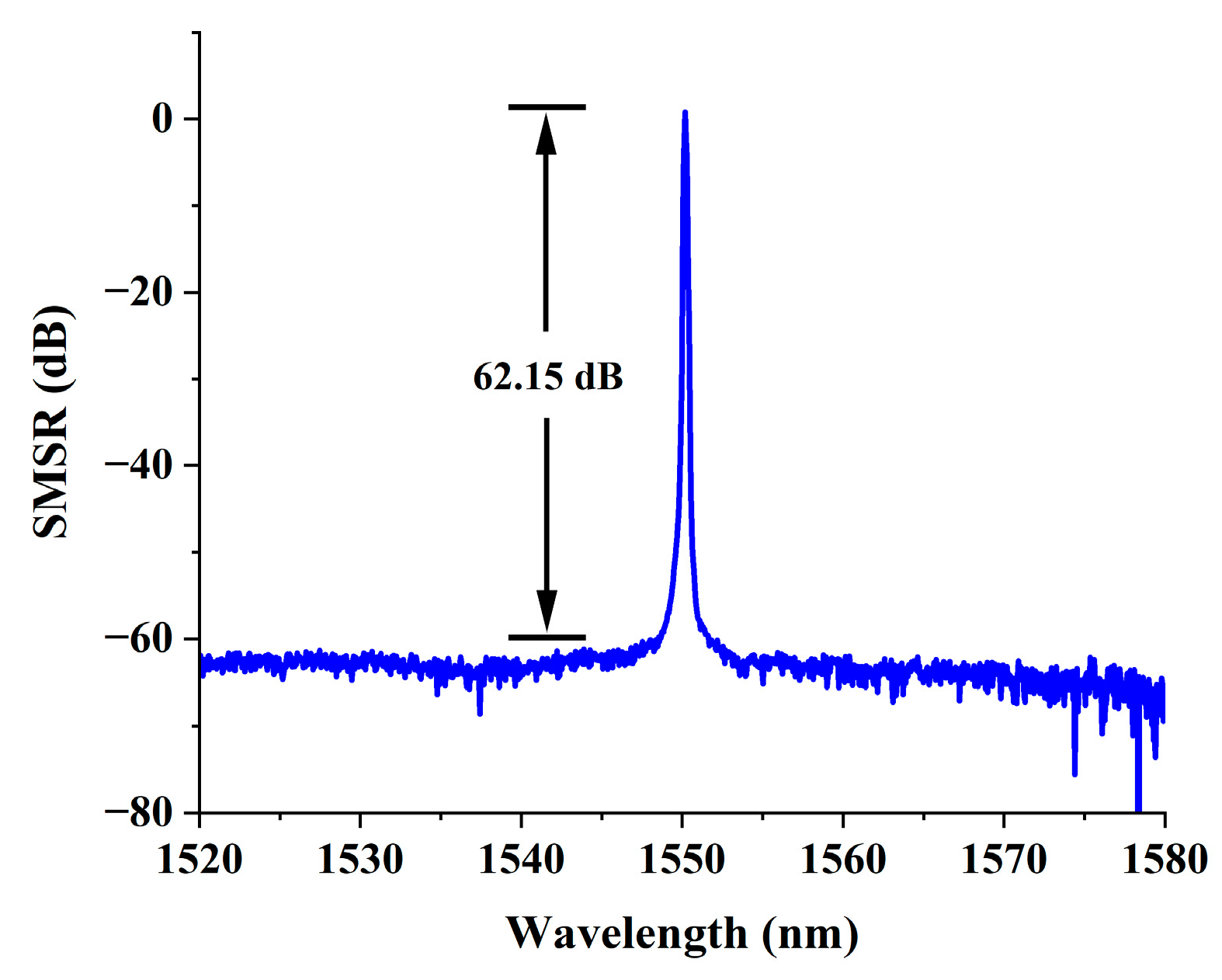The Effect of Lens Focal Length on the Output Characteristics of 1.55 μm Tunable External-Cavity Semiconductor Lasers
Abstract
1. Introduction
2. TECSL Basic Principles
2.1. TECSL Basic Structure
2.2. TECSL Tuning Principle
3. TECSL Experimental Setup
4. TECSL Test Results and Analysis
4.1. Effect of Lens Focal Length on TECSL Tuning Range
4.2. Effect of Lens Focal Length on Threshold Current
4.3. Effect of Lens Focal Length on Output Power
4.4. Effect of Lens Focal Length on SMSR
5. Conclusions
Author Contributions
Funding
Institutional Review Board Statement
Informed Consent Statement
Data Availability Statement
Acknowledgments
Conflicts of Interest
References
- Mroziewicz, B. External cavity wavelength tunable semiconductor lasers-a review. Opto-Electron. Rev. 2008, 16, 347–366. [Google Scholar] [CrossRef]
- Cui, Q.; Lei, Y.; Chen, Y.; Cheng, Q.; Ye, W.; Dexiao, Z.; Lutai, F.; Yue, S.; Peng, J.; Lei, L.; et al. Advances in wide-tuning and narrow-linewidth external-cavity diode lasers. Sci. China Inf. Sci. 2022, 65, 181401. [Google Scholar] [CrossRef]
- Tang, R.; Kita, T.; Yamada, H. Narrow-spectral-linewidth silicon photonic wavelength-tunable laser with highly asymmetric Mach–Zehnder interferometer. Opt. Lett. 2015, 40, 1504–1507. [Google Scholar] [CrossRef]
- Congar, A.; Gay, M.; Perin, G.; Mammez, D.; Simon, J.C.; Besnard, P.; Rouvillain, J.; Georges, T.; Lablonde, L.; Robin, T.; et al. Narrow linewidth near-UV InGaN laser diode based on external cavity fiber Bragg grating. Opt. Lett. 2021, 46, 1077–1080. [Google Scholar] [CrossRef] [PubMed]
- Jiang, L.; Lan, T.; Dang, L.; Li, J.; Huang, L.; Shi, L.; Yin, G.; Zhu, T. Ultra-narrow linewidth vertical-cavity surface-emitting laser based on external-cavity weak distributed feedback. Opt. Express 2022, 30, 37519–37525. [Google Scholar] [CrossRef]
- Jin, W.; Yang, Q.F.; Chang, L.; Shen, B.; Wang, H.; Leal, M.A.; Wu, L.; Gao, M.; Feshali, A.; Paniccia, M.; et al. Hertz-linewidth semiconductor lasers using CMOS-ready ultra-high-Q microresonators. Nat. Photonics 2021, 15, 346–353. [Google Scholar] [CrossRef]
- Lohmann, A.; Syms, R.R.A. External cavity laser with a vertically etched silicon blazed grating. IEEE Photonics Technol. Lett. 2003, 15, 120–122. [Google Scholar] [CrossRef]
- Komljenovic, T.; Srinivasan, S.; Norberg, E.; Davenport, M.; Fish, G.; Bowers, J.E. Widely tunable narrow-linewidth monolithically integrated external-cavity semiconductor lasers. IEEE J. Sel. Top. Quantum Electron. 2015, 21, 214–222. [Google Scholar] [CrossRef]
- Shin, D.K.; Henson, B.M.; Khakimov, R.I.; Ross, J.A.; Dedman, C.J.; Hodgman, S.S.; Baldwin, K.G.H.; Truscott, A.G. Widely tunable, narrow linewidth external-cavity gain chip laser for spectroscopy between 1.0–1.1 µm. Opt. Express 2016, 24, 27403–27414. [Google Scholar] [CrossRef]
- Wang, L.; Shen, Z.; Feng, X.; Li, F.; Cao, Y.; Wang, X.; Guan, B.O. Tunable single-longitudinal-mode fiber laser based on a chirped fiber Bragg grating. Opt. Laser Technol. 2020, 121, 105775. [Google Scholar] [CrossRef]
- Volet, N.; Yi, X.; Yang, Q.F.; Stanton, E.J.; Morton, P.A.; Yang, K.Y.; Vahala, K.J.; Bowers, J.E. Micro-resonator soliton generated directly with a diode laser. Laser Photonics Rev. 2018, 12, 1700307. [Google Scholar] [CrossRef]
- Laurent, A.; Chanclou, P.; Thual, M.; Lostec, J.; Gadonna, M. Double external cavity laser diode for DWDM applications. J. Opt. A Pure Appl. Opt. 2000, 2, L6. [Google Scholar] [CrossRef]
- Antil, R.; Pinki, S.B.; Beniwal, S. An overview of DWDM technology & network. Int. J. Sci. Technol. Res. 2012, 1, 43–46. [Google Scholar]
- Kita, T.; Tang, R.; Yamada, H. Narrow spectral linewidth silicon photonic wavelength tunable laser diode for digital coherent communication system. IEEE J. Sel. Top. Quantum Electron. 2016, 22, 23–34. [Google Scholar] [CrossRef]
- Wang, F.; Jia, S.; Wang, Y.; Tang, Z. Recent developments in modulation spectroscopy for methane detection based on tunable diode laser. Appl. Sci. 2019, 9, 2816. [Google Scholar] [CrossRef]
- Feng, S.; Qiu, X.; Guo, G.; Zhang, E.; He, Q.; He, X.; Ma, W.; Fittschen, C.; Li, C. Palm-sized laser spectrometer with high robustness and sensitivity for trace gas detection using a novel double-layer toroidal cell. Anal. Chem. 2021, 93, 4552–4558. [Google Scholar] [CrossRef]
- Newman, Z.L.; Maurice, V.; Drake, T.; Stone, R.J.; Briles, T.C.; Spencer, D.T.; Fredrick, C.; Li, Q.; Westly, D.; Ilic, B.R.; et al. Architecture for the photonic integration of an optical atomic clock. Optica 2019, 6, 680–685. [Google Scholar] [CrossRef]
- Choi, S.U.; Han, S.C.; Yun, J.I. In situ detection of neodymium isotopes using tunable diode laser absorption spectroscopy for nuclear forensic analysis. J. Anal. At. Spectrom. 2023, 38, 166–173. [Google Scholar] [CrossRef]
- Olesberg, J.T.; Arnold, M.A.; Mermelstein, C.; Schmitz, J.; Wagner, J. Tunable laser diode system for noninvasive blood glucose measurements. Appl. Spectrosc. 2005, 59, 1480–1484. [Google Scholar] [CrossRef]
- Vijay, J.; Singh, K.; Soni, D.; Rathi, A. Structural and optical characteristics of nanoscale semiconductor lasers for telecommunication and biomedical applications: A review. IOP Conf. Ser. Mater. Sci. Eng. 2019, 594, 012002. [Google Scholar] [CrossRef]
- Cai, H.; Tao, J.F.; Gu, Y.D.; Kwong, D.L.; Liu, A.Q. Demonstration of a single-chip integrated MEMS tunable laser with a large wavelength tuning range. In Proceedings of the 2013 IEEE International Electron Devices Meeting, Washington, DC, USA, 9–11 December 2013. [Google Scholar]
- Wang, Y.; Ding, K.; Wu, H.; Zhao, T.; Wu, Y.; Cui, Q.; Chen, Y.; Lei, Y.; Qin, L. Tunable Narrow Linewidth External Cavity Diode Laser Employing Wide Interference Filter and Diffraction Grating. Appl. Sci. 2023, 13, 10790. [Google Scholar] [CrossRef]
- Bennetts, S.; McDonald, G.D.; Hardman, K.S.; Debs, J.E.; Kuhn, C.C.N.; Close, J.D.; Robins, N.P. External cavity diode lasers with 5 kHz linewidth and 200 nm tuning range at 1.55 μm and methods for linewidth measurement. Opt. Express 2014, 22, 10642–10654. [Google Scholar] [CrossRef] [PubMed]
- Gao, F.; Luo, S.; Ji, H.M.; Yang, X.G.; Yang, T. Enhanced performance of tunable external-cavity 1.5 μm InAs/InP quantum dot lasers using facet coating. Appl. Opt. 2015, 54, 472–476. [Google Scholar] [CrossRef]
- Gao, F.; Luo, S.; Ji, H.M.; Yang, X.G.; Liang, P.; Yang, T. Broadband tunable InAs/InP quantum dot external-cavity laser emitting around 1.55 μm. Opt. Express 2015, 23, 18493–18500. [Google Scholar] [CrossRef] [PubMed]
- Wang, Y.; Wu, H.; Chen, C.; Zhou, Y.; Wang, Y.; Liang, L.; Tian, Z.; Qin, L.; Wang, L. An ultra-high-SMSR external-cavity diode laser with a wide tunable range around 1550 nm. Appl. Sci. 2019, 9, 4390. [Google Scholar] [CrossRef]
- Yuan, H.H.; Gao, F.; Yang, T. Ultra-broadband tunable single-and double-mode InAs/InP quantum dot external-cavity laser emitting around 1.65 μm. Opt. Lett. 2018, 43, 3025–3028. [Google Scholar] [CrossRef]
- Wu, P.; Tang, S. Wavelength-tunable laser based on electro-optic effect. In Proceedings of the Laser Resonators, Microresonators, and Beam Control XVII, San Francisco, CA, USA, 7–12 February 2015. [Google Scholar]









| Researchers | Tuning (nm) | SMSR (dB) | Current (mA) | Power (mW) |
|---|---|---|---|---|
| H. Cai et al. [21] | 48.3 | 28 | - | - |
| Yan Wang et al. [22] | 89 | 55 | 200 | 25.6 |
| Feng Gao et al. [24] | 104 | - | 1000 | 34 |
| Feng Gao et al. [25] | 140.4 | - | 1500 | 6 |
| Pengfei Wu et al. [28] | 80 | - | 500 | 100 |
| Our Team | 152.3 | 62.15 | 200 | 42.36 |
Disclaimer/Publisher’s Note: The statements, opinions and data contained in all publications are solely those of the individual author(s) and contributor(s) and not of MDPI and/or the editor(s). MDPI and/or the editor(s) disclaim responsibility for any injury to people or property resulting from any ideas, methods, instructions or products referred to in the content. |
© 2024 by the authors. Licensee MDPI, Basel, Switzerland. This article is an open access article distributed under the terms and conditions of the Creative Commons Attribution (CC BY) license (https://creativecommons.org/licenses/by/4.0/).
Share and Cite
Li, X.; Zhang, L.; Luo, W.; Shi, J.; Zheng, Z.; Kong, H.; Qiu, M.; Sun, K.; Li, Z.; Qu, Y.; et al. The Effect of Lens Focal Length on the Output Characteristics of 1.55 μm Tunable External-Cavity Semiconductor Lasers. Photonics 2024, 11, 809. https://doi.org/10.3390/photonics11090809
Li X, Zhang L, Luo W, Shi J, Zheng Z, Kong H, Qiu M, Sun K, Li Z, Qu Y, et al. The Effect of Lens Focal Length on the Output Characteristics of 1.55 μm Tunable External-Cavity Semiconductor Lasers. Photonics. 2024; 11(9):809. https://doi.org/10.3390/photonics11090809
Chicago/Turabian StyleLi, Xuan, Linyu Zhang, Wei Luo, Junce Shi, Zhaoxuan Zheng, Huiyin Kong, Meiye Qiu, Kangxun Sun, Zaijin Li, Yi Qu, and et al. 2024. "The Effect of Lens Focal Length on the Output Characteristics of 1.55 μm Tunable External-Cavity Semiconductor Lasers" Photonics 11, no. 9: 809. https://doi.org/10.3390/photonics11090809
APA StyleLi, X., Zhang, L., Luo, W., Shi, J., Zheng, Z., Kong, H., Qiu, M., Sun, K., Li, Z., Qu, Y., Qiao, Z., & Li, L. (2024). The Effect of Lens Focal Length on the Output Characteristics of 1.55 μm Tunable External-Cavity Semiconductor Lasers. Photonics, 11(9), 809. https://doi.org/10.3390/photonics11090809





